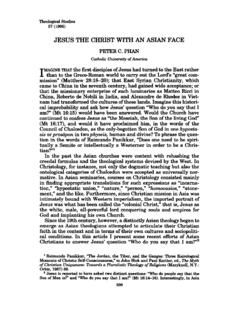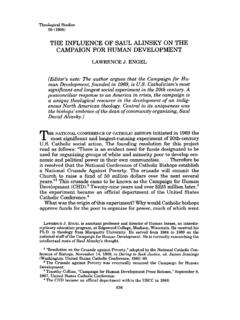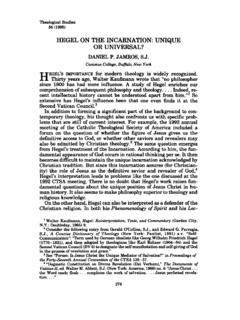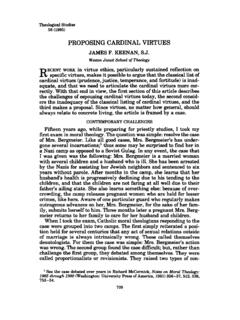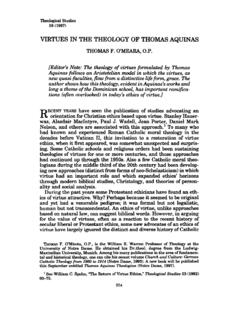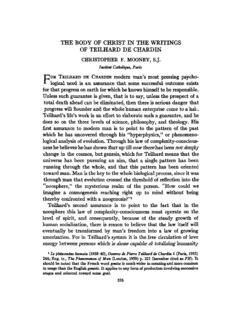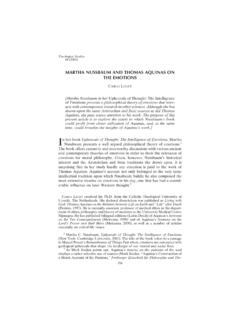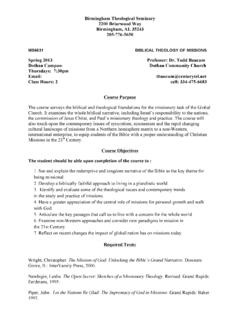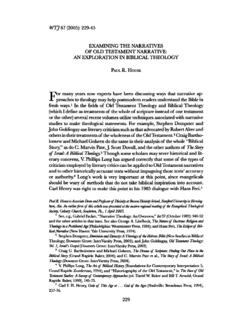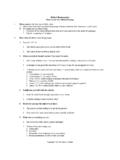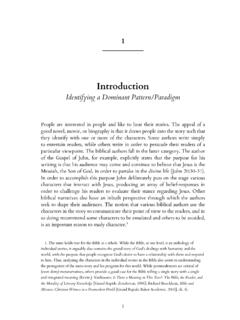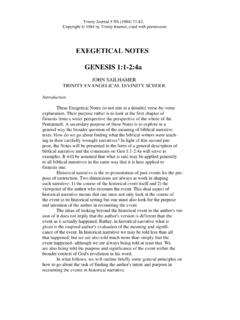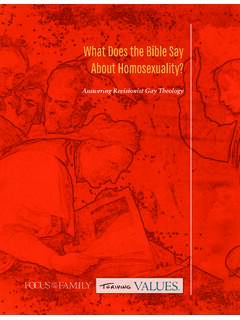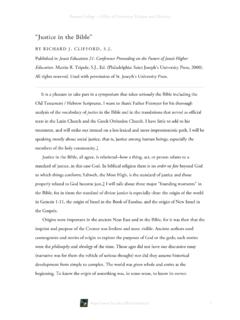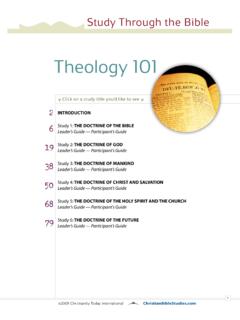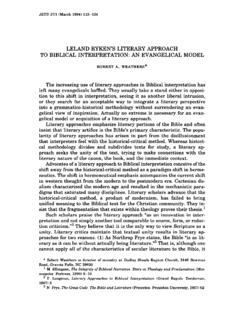Transcription of CRISIS IN JERUSALEM? NARRATIVE CRITICISM IN …
1 Theological Studies 50 (1989) CRISIS IN JERUSALEM? NARRATIVE CRITICISM IN NEW TESTAMENT STUDIES PHEME PERKINS Boston College, Chestnut Hill, Mass. HISTORICAL-CRITICAL STUDY of the New Testament recognized from the beginning that in the context of the great classical works even the best of NT writings cannot be considered "literature. " For English speakers, the noble prose of the Authorized Version coupled with an idealized, romantic interpretation of the religious content of the NT kept this fact from the consciousness of literary critics and English depart-ments that continue to treat the "Bible as literature" within the bound-aries of the Western literary As a result, literary studies of the Bible are often considered spurious to the serious task of NT scholars: historical-critical analysis and theological interpretation. Though historical CRITICISM tended to emphasize the development of NT writings out of smaller units of tradition and the correlation of such tradition histories with the emergence of distinctive religious language and theological ideas, it could not ignore altogether the challenge posed by ancient literature.
2 What, if any, literary models did the various authors use in composing their works? How does a presumed genre shape the message which the author presents to the first-century reader? Attempts to answer these questions have created a flood of analyses of ancient literary remains that do not enjoy "classical" status, such as romances, fragments of ethnic histories, school books on rhetoric, papyrus letters, and the The study of ancient literary composition plays an important role in the task of redaction CRITICISM . The exegete is asked to construct a "theology" of a given Gospel on the basis of the way in which the author has edited and arranged traditional materials. Usually such theologies 1 See the discussion of this phenomenon in A. Wilder, Early Christian Rhetoric: The Language of the Gospel (Cambridge: Harvard University, 1971) xi-xxx.
3 2 These debates and their associated literature have been ably summarized by D. E. Aune, The New Testament in Its Literary Environment (Philadelphia: Westminster, 1987). Aune's treatment is particularly important because it recognizes that both Greco-Roman and Jewish materials must be taken into account in describing the context of NT writings. Aune finds the Christian literary problem exemplified in Paul's own combination of Jewish traditions and Hellenistic rhetorical forms: "The Christianity reflected in Paul's letters is consciously rooted theologically in this Judaism and yet is struggling to discard the cultural markers of Jewish ethnic identity" (12). 296 NARRATIVE CRITICISM 297 emphasize the Christology of the individual Attention to ancient literary patterns may prevent the exegete from drawing false conclusions about the significance of particular features in a gospel. For example, the frequent misunderstanding by Jesus' disciples in Mark are neither his-torical reports nor the theological devaluation of Christians attached to Jesus as miracle worker.
4 Misunderstanding of divine revelation is char-acteristic of writings claiming to present revealed teaching throughout the period. As part of the stock literary content one also finds the encounter with hostile authorities and accounts of the weaknesses of the followers of the great This comparative approach has also fueled debates about the historical and biographical intent of the evangelists. Pointing to such common elements as an edifying or ideological point of view, entertaining fictions, constructed speeches, and fictional episodes in other ancient writings which are nonetheless considered historical or biographical, some scholars are abandoning the radical skepticism of the earlier historical-critical method, which had insisted that one could recover nothing except the ideology of the evangelists from the gospel Since the materials required to study NT writings in their ancient context are even less accessible than the established classics, the gap between such study and treatment of the Bible as literature by literary critics remains.
5 The most powerful presentation of biblical NARRATIVE as 3 Some critics pursue the redaction-critical task by first constructing a detailed map of source material and editing by the evangelist, as in R. T. Fortna's The Fourth Gospel and Its Predecessor: From NARRATIVE Source to Present Gospel (Philadelphia: Fortress, 1988). Others do so by isolating structural elements that result from the use of transitional passages (for a critic of this method, see C. W. Hedrick, "The Role of Summary Statements in the Composition of the Gospel of Mark: A Dialogue with Karl Schmidt and Norman Perrin," Novum Testamentum 26 [1984] 289-311), or the positioning and use of key Christological titles ( , J. D. Kingsbury, The Christology of Mark's Gospel [Philadelphia: Fortress, 1983]). In some cases a particular theme may be seen as structuring both the NARRATIVE and the Christology of a Gospel.
6 D. Lee-Pollard has proposed that Mark is shaped around power and powerlessness. The opening sections demonstrate the immense power of the kingdom in Jesus' ministry; the passion, its renunciation in obedient trust in God, which is at the same time the triumphant coming of God's rule and destruction of the temple ("Powerlessness as Power: A Key Emphasis in the Gospel of Mark," Scottish Journal of Theology 40 [1987] 173-88). 4 Aune, New Testament 55-56. 5 So Aune, ibid. 55-65, 80; and from the perspective of a detailed study of the literary presentation of Galilee in the gospels complemented by archeology and sociological recon-struction of the Jesus movement, S. Freyne, Galilee, Jesus and the Gospels: Literary Approaches and Historical Investigations (Philadelphia: Fortress, 1988). J. H. Charlesworth has also mounted a defense of historical Jesus research based on analyses of intertestamen-tal Jewish writings and archeological investigation (Jesus within Judaism [New York: Doubleday, 1988]).
7 298 THEOLOGICAL STUDIES a formative element in the Western literary canon in recent years has been Northrop Frye's construction of biblical However, the " NARRATIVE " in this instance is a great construct of biblical history from Exodus through the Apocalypse from which the types of metaphors emerge as embedded in different writings of the Bible. The NARRATIVE patterns of individual writings or the peculiarities of their authors have all been swallowed up into the A more nuanced position on these issues is evident in The Literary Guide to the Bible edited by a specialist in OT literary analysis, Robert Alter, and the distinguished professor of English literature Frank Christian treatment of Jewish Scrip-tures in terms of type and antitype, as well as the plotting of "world history," is carefully distinguished from a Jewish or literary reading of the same writings.
8 The diverse mixture of authors, both exegetes and literary critics, as well as a varying understanding of literary analysis and disagreement over whether the text to be analyzed is a text-critically reconstructed Hebrew or Greek original, the Authorized Version, or some other English rendering, makes the volume a better example of the problems in attempting such a task than a guide. Exegetes dissatisfied with the literary analyses appropriate to historical CRITICISM have approached the NT narratives with methods of literary analysis taken from contemporary CRITICISM . Two elements of the redac-tional-critical approach make its use of literary parallels invalid as literary CRITICISM in this view. First, redaction CRITICISM fails to perceive that the form of the work as a whole and the reader's participation in that work is the goal of interpretation, not moving from the text to Second, redaction CRITICISM is the victim of a literalist fallacy that underlies the treatment of biblical NARRATIVE from the beginnings of modern CRITICISM : it mistakes realistic NARRATIVE for claims about a historical reality seen through the Historical critics may well eN.
9 Frye, The Great Code: The Bible and Literature (New York: Harcourt Brace Jovanovich, 1982). 7 Frye's construction is certainly a brilliant demonstration of the way in which the biblical code shapes English literature. However, typology not only destroys the literary qualities of the NARRATIVE wholes within the canon; it has also been the weapon by which Christian apologists have misread and reshaped Hebrew Scriptures to their own ends. Harold Bloom protests that Frye stands in a long line of such apologists (in H. Bloom, ed., The Gospels [New York: Chelsea House, 1988] 1-15). 8 Cambridge: Harvard University/Belknap, 1987. 9 W. A. Beardslee, Literary CRITICISM of the New Testament (Philadelphia: Fortress, 1970) 1-13. 10 The emerging concern for NT NARRATIVE has been strongly influenced by Hans Frei's account of the historical turn away from biblical NARRATIVE in 18th- and 19th-century hermeneutics (The Eclipse of biblical NARRATIVE [New Haven: Yale, 1974]).
10 It should be noted that the CRITICISM has contributed little to the solution. The problem of a hermeneutics NARRATIVE CRITICISM 299 object to both challenges. While reader participation in creating the meaning of the text can even be seen in the work of exegetes, modern Western aesthetic and emotive responses cannot be projected onto an-cient audiences. Much of the detail of comparative material from the ancient world that loads our commentaries, not to mention the major difficulties faced when we translate into modern languages, is an effort to create a more appropriate context for evoking meaning and engage-ment with the text than can be derived from literary theorists. Second, " NARRATIVE realism" is simply a variant of first-order naivete about the text. It presumes an author in imaginative control of a fictional world which he or she creates.
